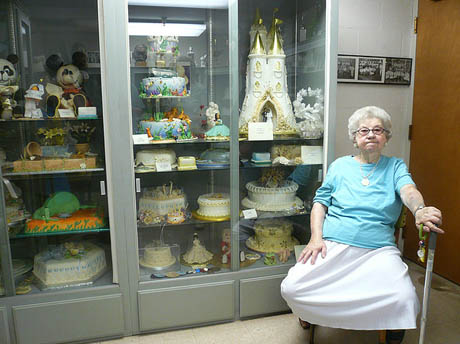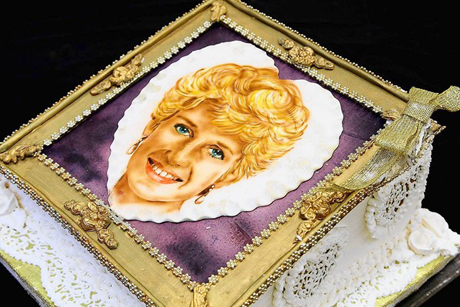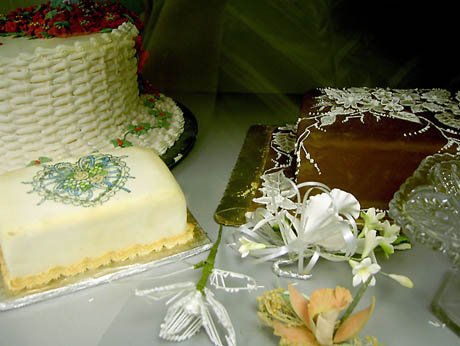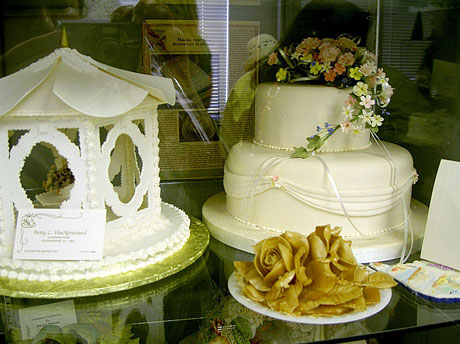I learned of the existence of the world’s first and, to the best of my knowledge, only cake museum in the same moment as I heard the shocking news that its continued survival is under threat due to budget problems in the Los Angeles Unified School District.

IMAGE: Frances Kuyper and part of her cake collection, photographed in 2007 by Flickr user jericl cat
The cake museum was founded in 1994 by Frances Kuyper, a vaudeville performer turned cake decorator extraordinaire who was “known for her pioneering use of the airbrush,” according to the Los Angeles Times. In fact, as fellow member of the International Cake Exploration Societé Carolyn Mathewson elaborated, “She was the first to airbrush a cake without blowing holes in the frosting.”

IMAGE: Princess Diana, on a cake model decorated by Frances Kuyper in the 1990s, and photographed by Gary Friedman for the Los Angeles Times.
The museum’s collection of more than 140 cakes is actually inedible — their plastic or styrofoam bases simply serve as a foundation to showcase many of the most advanced techniques in sugar-work and decoration. Their first public display was in Pasadena, in a building next to Kuyper’s home that “she and her husband, retired mailman Frankie Kuyper, spent their $40,000 savings on converting into an exhibition area” — preparations that included, according to a 1996 Los Angeles Times report, a preemptive vermin strike:
“I had the place fogged with bug bombs before I opened,” said Kuyper, 78. “I have a termite guy come every month. I’ve tried to think of everything.”
When Frankie passed away and Frances moved to a Boyle Heights retirement community, its administrators allowed her to relocate the museum to its basement, where she continued to receive visitors and conduct tours and demonstrations by appointment until her death in July 2010.

IMAGE: A photograph of the cakes on display in their retirement community basement home, taken by Pleasure Palate in 2007.
Once again, the LA Times, whose cake museum coverage has been exemplary, was on the story, noting the uncertainty over the museum’s fate in Kuyper’s obituary, and following up with the thrilling tale of its rescue in August 2010, when “bakery students from a San Fernando Valley vocational school saved more than a hundred colorfully decorated cakes from a trip to the dumpster.”
As the article elaborates, the rescue mission was orchestrated by Susan Holtz, a culinary department instructor at the West Valley Occupational Center in Woodland Hills who had been in the habit of bringing her students to visit Frances Kuyper and study the cake collection.
Upon hearing of Frances’ death, Holtz called the retirement home and learned that they were just two weeks’ away from throwing the cakes out. She quickly arranged to find space for them at the vocational college, “recruiting student draftsmen from the school’s computer-aided design class to draw up permanent displays for the cakes and fledgling woodworkers from its carpentry class to build them.”

IMAGE: A photograph of the cakes on display in their retirement community basement home, taken by Pleasure Palate in 2007.
As Holtz explained to the LA Times reporter, Bob Pool, back in 2010:
These are famous cakes. They show a lot of advanced techniques. […] There are really important people in the industry here. About three dozen cake artists are represented. Look at this upside-down pineapple cake. It’s famous; it’s in books. Colette Peters of New York did it. She made cakes for royalty. They fly in their own seats when they’re delivered on planes.
However, as Pool reported yesterday, in his most recent cake museum update, budget troubles prompted LAUSD to cut its adult education offerings in half earlier this month, and West Valley Occupational Center’s entire teaching, administrative and support staff all received layoff notices. With the culinary program and the school’s future uncertain, the cakes are currently in limbo. Holtz told Pool that she left “signs begging that she be called at home before the district throws out of any of Kuyper’s cakes if the culinary program is permanently scrapped.”
“I’ll rent a storage unit if I have to,” Holtz said. “I don’t want these cakes to be thrown out. We have a lot of history in these. They cannot be thrown out.”
The fate of a fifty-year-old textbook example of Lambeth overpiping or a virtuoso yet rather terrifying airbrush portrait of Princess Diana may not be the most critical issues facing civilisation at this moment, but, nonetheless, the destruction of the world’s first and only cake museum seems like an unnecessary and avoidable minor tragedy. Fellow cake enthusiasts: Can you help?
NOTE: Thanks to Geoff Manaugh for alerting me to both the cake museum’s existence and uncertain future!

